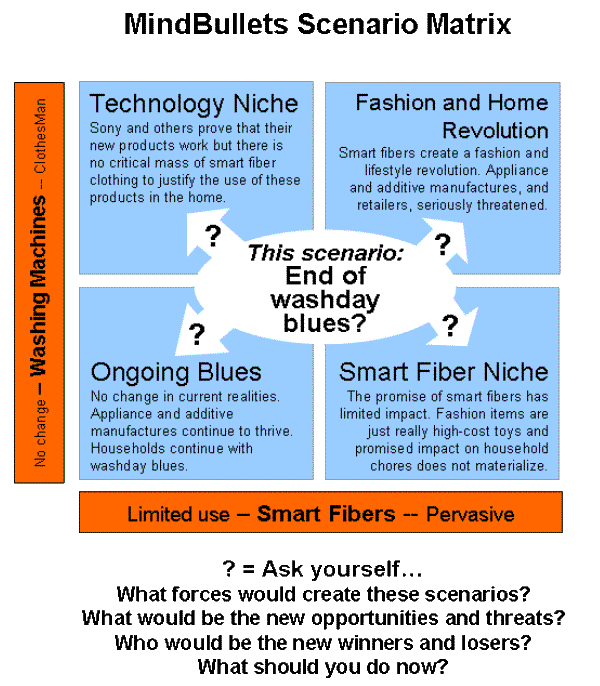
Dream a little. It’s the year 2020. You’re relaxing at home. Your grandchild is riding your knee like an imaginary horse.
Suddenly his eyes light up and he says to you: “Hey gramps! Mom just told me that back in 2000 you used to wash your clothes by boiling them in water. She says that you had a big white metal box in the kitchen, with a round window in it. You could watch your clothes going round like television. Cool! Hey, you didn’t really put blue gooky chemicals on your clothes, boil them and hang them out in the garden to dry? Did you?”
Yes we did. And we still do. But all that is about to end. A product launched by Sony this week is about to turn the washing and ironing chore on its head.
It’s no larger than a matchbox, it sticks to the inside of any cupboard and it makes sure you will never have to wash and iron your clothes again. Just close your cupboard door and the tiny ultrasound device will shake the dust and grime right out of your clothes. And, if your clothes are made from one of NuTech’s new ‘shape memory’ fabrics, they will simply return to their new shape in moments. Too good to be true? Not anymore.
Sony’s new ClothesMan product has been launched in US and European markets in a joint announcement with NuTech. A myriad of popular brands including Levi Strauss, FCUK and Gap are stocking stores with their latest designs in NuTech’s smart fabrics to coincide with the launch.
(Read the full story in the detailed Analysis/Synthesis section – for subscribers only)
ANALYSIS >> SYNTHESIS: How this scenario came to be
Timeline
2003: Technological building blocks
Ultrasound devices are in common use by therapists to aid healing of injuries and by surgeons in performing targeted tissue repair.
Shape Memory Alloys (materials created with a semi-permanent ‘memory’ of their shape) are found in leading-edge applications. They will gradually return to their original shape when distorted (e.g. bumpers on the Mitsubishi Pajero) or will change their shape in response to a change in temperature, or light, or sound (e.g. in medical applications)
2004: Smart materials emerge
New features are developed in Smart Materials and Smart Fibers. DuPont, a company that has been active in this field since their early successes with Kevlar® (used in bullet-proof vests) and Lycra® (who doesn’t use it!), are now developing Smart Materials which include features that can make them nearly invisible, others that can harden on command (e.g. for use as splints by the US Army), and others still can change colour and shape on command.
2005: Fashion-enhanced natural fibres
The first companies start producing fashion-enhanced GM cottons. Scientists have worked out how to put blue colour genes into the cotton plant so that it grows cotton that is already blue instead of white. The idea is to use the cotton to make denim jeans without needing to use toxic indigo dyes. Soon you will be wearing designer genes!
2007: e-Fashion lights up
The first OLEP fashion fabric comes onto the market. Organic light emitting polymers (OLEPs) are made up of thin films of organic materials that give off light of various colors when voltage is applied to them. (see also the MindBullet on this topic – see links below). The first products are shirts and T-shirts that can be any color, any pattern of your choosing.
New fibers allow control of insulation qualities of fabrics – use the same shirt for warm weather and cold weather.
New polyamide fibers with an embedded bacterio-static agent promise to prevent the development of odors in clothes.
Announced in time for the year-end retail season: shoes and handbags covered in OLEPs, one product that goes with any outfit – just download the appropriate software from your mobile phone.
2008: Memory fibres mass-produced
The first OLEP shirt with full video capability comes onto the market. Bono wears a prototype T-shirt at the Oscars ceremony and wows the audience by showing clips from U2’s latest music video, on his shirt!
Organic Memory Fibers (OMF) are mass-produced for the first time and become cheap enough to be integrated into medium-price garments. Prices are said to be dropping at the rate of microprocessors – more than 50% per annum. NuTech licence their open technology widely and give it away freely to selected third-word countries.
Levis become the first to commercialize OMFs. They build a ‘natural wrinkle’ into their new range of 999 unisex jeans.
2009: A new fashion and household revolution
Sony’s announcement of their in-cupboard cleaning devices capitalizes on the growing popularity of shape-memory fabrics. The high-tech nature of these fabrics gives them enormous sex appeal for the young generation of consumers.
It is believed that sales opportunities for Sony’s ClothesMan products will be limited for the next 2 years but as these new fabrics become commoditized, Sony’s unique CSA (Cleaning Systems Architecture) will ensure a dominance in this market and may threaten manufacturers of traditional household appliances (washing machines, steam irons etc), washing powders and cleaning additives.
Sony are playing down the disruptive nature of their new product, saying that they will only target early-adopters and see how the market develops.
Customers, however, seem to have a different idea. Sony’s products are flying off the shelf causing a massive surge in demand for NuTech fabrics. Designers and clothing manufacturers in the Far East are starting to call it “a fashion revolution”.
Warning: Hazardous thinking at work
Despite appearances to the contrary, Futureworld cannot and does not predict the future. Our Mindbullets scenarios are fictitious and designed purely to explore possible futures, challenge and stimulate strategic thinking. Use these at your own risk. Any reference to actual people, entities or events is entirely allegorical. Copyright Futureworld International Limited. Reproduction or distribution permitted only with recognition of Copyright and the inclusion of this disclaimer.
